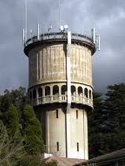From, a picturesque neighbourhood 20,000,000 gallons of water, provided by
the O'Shannassy scheme, will flow to the city when.required. Ahead of the weir
the O'Shannassy River gurgles - joyfully, among the stones in its shallow bed.
Through the gates the crystal water flows in a.strong stream to the aqueduct
running a serpentine course toward the city.
Beside the weir, In a poo formed in the old channel of the river, trout play
and flash in the sunlight. Around it all is a forest of gums and llghtwoods, and
graceful lines of tree fern Song birds and gaudy parrots fly overhead, mountains
tower on either side of the valley.
The maximum consumption of .water on any one day in the summer has' been.
about 70,000,000 gallons; .With the completion of tho O'Shannassy scheme for
augmenting the supply, the Beard of Works would be able to meet the summer
requirements of 800,000 people.. In some future time additional water will be
drawn from the Upper Yarra.
FIRST MOOTED IN 1888
Mr E. G. Ritchie, engineer of water supply to the
Board of Works, recalls the proposition to. divert the head waters of the Upper
Yarra (including its most important tributary, the O'Shannassy river), for the
purpose of the metropolitan water supply, first mooted in 1888 by Mr W.
Davidson, engineer of Melbourne water supply at that time.
PLANS CHANGED
It had been Intended to enlarge the Maroondah conduit from
25,000,000 to 60,000,000 gallons a day capacity, and lo construct a storage
reservoir of 2,000,000,000 gallons in the Maroondah Valley. The abnormal growth
of tho metropolitan population to the east and south-east, and its comparative
stagnation on the western and northern sides were the factors, says Mr Ritchie,
which made it necessary to recast the whole position. To provide for every
possible and probable development of the higher levels of the eastern and
south-eastern .metropolis by a gravitation supply it was deemed expedient by the
Board of Works to carry out the first step In the Upper Yarra scheme by a
conduit as far as' the O'Shannassy river, before completing the Maroondah
scheme. This action was necessary, because the Maroondah aqueduct would riot
serve the higher levels referred to except by resorting to pumping, which was
undesirable, and was shown to be more costly than a new and separate high level
conduit from the O'Shannassy river.
SURVEY BEGUN
In 1910 the whole of the O'Shannassy watershed of 32,600
acres was vested in the Metropolitan Board of Works for water supply purposes.
The permanent survey was begun in 1910, and the first contact for construction
lot in October, 1911. By November, 1912, contracts for practically the whole of
the pipe lines and aqueducts, aggregating 49 miles, had been arranged. The total
cost of the scheme was estimated. at £450,000. .Until that estimate was made,
wages and cost of materials have Increased. But the work has been completed
under the estimate, and at an average rate of speed In construction less than
any rate previously recorded In connection with the Board. The dry weather
experienced last winter enabled the contractors to push ahead with tunnellng,
and the formation of the aqueduct in the final stages of the undertaking. For
miles along the mountain side, the aqueduct runs its sinuous course through
forests, set upon steep banks and ferny valleys, amid beautiful scenes, which
should attract hosts of tourists.
Sometimes tho water. passes through tunnels holding the walls. From Warburton
to the weir is 31 miles. Construction had to be carried out on steep mountain
sidings, so steep that great difficulty was experienced in securing the earth
embankments. Sometimes the country moved and wrought destruction. Great banks of
stony ground had to be reinforced by steel.
HOW THE PIPELINE GOES
At a point about two miles west of the Don the great
pipes lead the way clown a steep descent, and the pipe line streaks across the
Yarra Valley, near Wandin. Then there is a channel around the hillside to a
point n«near Lilydale. whence the water flows In pipes through Croydon,
Ringwood. Mitcham to Surrey Hills reservoirs, one with a capacity of 15,000.000
gallons. The weir is a substantial structure, and situated as it is in a narrow
valley. it has been necessary to make, provision auxiliary weirs and flood
gates.
The water, delivered to the aqueduct, passes through a close grilling into a
large basin, and over a monitoring-weir into the channel. On the way to .urrey
Hills there are other close gratings lo arrest any animals or other matters
which might enter the channel. Sometimes a snake comes swimming on the swift
water. It is caught in the grating, which, with others, is cleared every day by
a patrol. Wallabies, and oven deer, are among the Involuntary bathers. The
aqueduct is still an attraction to the bush animals, which may be wiser
by-and-by.

